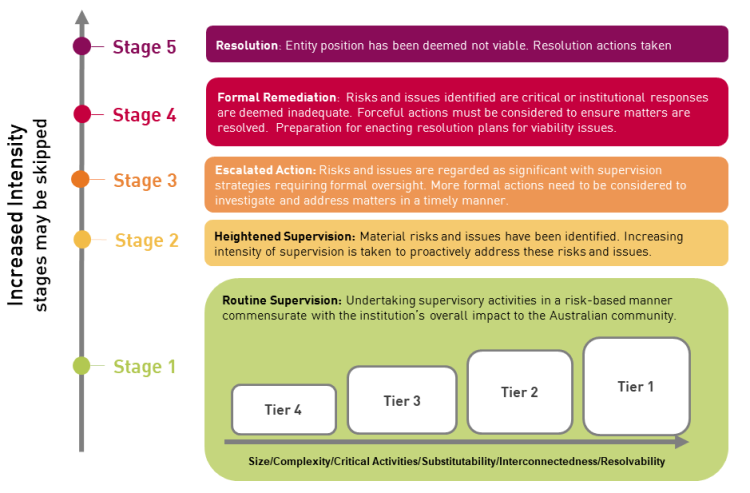Industry Supervision Frequently Asked Questions
1. Why is APRA replacing PAIRS and SOARS?
Since its inception in 2002, the PAIRS and SOARS framework has served APRA well by providing a structured and disciplined approach to assessing risks and allocating supervisory resources. However, over recent years, the type and nature of prudential risks has evolved. Risks in areas such as governance, culture, remuneration and accountability (GCRA), operational resilience and cybersecurity have increased in prominence and APRA has intensified its focus on member outcomes in superannuation.
Such developments triggered a review of APRA’s PAIRS and SOARS framework, resulting in the development of a new model that is more contemporary - called the Supervision Risk and Intensity Model (SRI Model).
2. What does the SRI Model do?
Like its predecessor, the SRI model assesses the level of prudential risk within APRA’s regulated entities across a number of (revised) risk categories and helps focus APRA’s resources to entities of greater risk.
3. How is the SRI Model different to PAIRS and SOARS?
The SRI Model’s design features ensure greater elevation of non-financial risks whilst preserving the importance of financial resilience. The model introduces recovery and resolution considerations and incorporates the impact of the external environment on an entity’s risk profile. It caters for industry nuances and is aligned with APRA’s enforcement approach to ensure a timely and appropriate supervisory response. The SRI model also embeds a degree of flexibility to cater for new and emerging risks in response to a changing environment.
4. How does the SRI Model work?
The SRI Model has three core elements: tiering, risk assessment and staging.
- Tiering – an entity’s tier reflects the potential impact that entity failure, imprudent behaviour or operational disruptions could have on financial stability, economic activity and the Australian community. An entity’s tiering is significant in determining the level of supervisory attention required to ensure adequate identification of risks and follow up of actions. An overview of the tiers is below1.
Tier 1 Individual entities that could have a large systemic impact. Tier 2 Individual entities that could have a systemic impact. Tier 3 Individual entities that are unlikely to have a systemic impact. Tier 4 Individual entities that would not have a systemic impact. - Risk assessment – all entities are subject to a risk assessment against a number of key risk categories. These categories are generally consistent across industries but allow for certain industry-specific factors and can be adjusted as risks change. The depth of risk assessment applied by APRA is commensurate with the tiering. This means that entities of higher systemic importance (i.e. in a higher tier) will be subject to more detailed risk assessment than those in lower tiers.
- Staging – the risk assessment will translate into an overall supervisory stage for the entity. This staging will impact APRA’s overall supervision strategy and actions and, in certain circumstances, will require supervisors to consider the appropriate use of enforcement action depending on the seriousness of the risks identified. There are five stages:

Footnote:
1 Further information can be found in the SRI Model Guide.
5. What will be the impact on my entity of the introduction of the SRI model?
The move to the SRI Model could lead to a change in the intensity of supervision for some entities. This could differ from the current APRA supervisory stance under the PAIRS and SOARS framework. Until such time as APRA undertakes its SRI risk assessment, an entity’s current PAIRS and SOARS settings will remain.
6. When will I know the new SRI rating for my entity?
The transition from PAIRS and SOARS to the SRI Model commences in October 2020 and will be completed by June 2021. Entities will be advised of their tier and stage once their first SRI assessment is completed. The entity’s tier and stage must remain confidential in line with existing protocols for an entity’s PAIRS and SOARS results.
7. Where can I find more information about the SRI Model?
APRA has released an SRI Model Guide with more detail on its design characteristics. A copy of the SRI Model Guide can be accessed here.
APRA will commence a series of structured engagements in November 2020 to help industry understand how it works, and what impact it may have on the level and intensity of supervision APRA applies.
If you have a question that is not addressed via the SRI Model Guide or the FAQs, please contact your APRA supervisor.